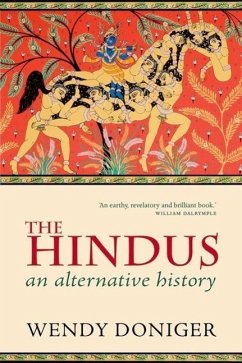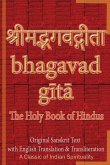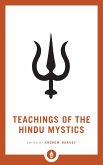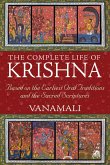29,99 €
inkl. MwSt.
Versandfertig in 2-4 Wochen

15 °P sammeln
- Broschiertes Buch
- Merkliste
- Auf die Merkliste
- Bewerten Bewerten
- Teilen
- Produkt teilen
- Produkterinnerung
- Produkterinnerung
An engrossing and definitive narrative account of history and myth that offers a new way of understanding one of the world's oldest major religions from one of the world's foremost scholars on Hinduism.
Andere Kunden interessierten sich auch für
![Bhagavad Gita, The Holy Book of Hindus Bhagavad Gita, The Holy Book of Hindus]() SushmaBhagavad Gita, The Holy Book of Hindus10,99 €
SushmaBhagavad Gita, The Holy Book of Hindus10,99 €![Teachings of the Hindu Mystics Teachings of the Hindu Mystics]() Andrew HarveyTeachings of the Hindu Mystics17,99 €
Andrew HarveyTeachings of the Hindu Mystics17,99 €![Religion in Practice Religion in Practice]() Swami PrabhavanandaReligion in Practice49,99 €
Swami PrabhavanandaReligion in Practice49,99 €![A Dictionary of Hinduism A Dictionary of Hinduism]() Margaret Stutley and JamesA Dictionary of Hinduism51,99 €
Margaret Stutley and JamesA Dictionary of Hinduism51,99 €![Hindus Hindus]() Julius LipnerHindus41,99 €
Julius LipnerHindus41,99 €![The Complete Life of Krishna The Complete Life of Krishna]() VanamaliThe Complete Life of Krishna20,99 €
VanamaliThe Complete Life of Krishna20,99 €![Aham Sphurana - A Glimpse of Self Realisation [Limited Edition] Aham Sphurana - A Glimpse of Self Realisation [Limited Edition]]() Sri Ramana MaharshiAham Sphurana - A Glimpse of Self Realisation [Limited Edition]31,99 €
Sri Ramana MaharshiAham Sphurana - A Glimpse of Self Realisation [Limited Edition]31,99 €-
-
-
An engrossing and definitive narrative account of history and myth that offers a new way of understanding one of the world's oldest major religions from one of the world's foremost scholars on Hinduism.
Hinweis: Dieser Artikel kann nur an eine deutsche Lieferadresse ausgeliefert werden.
Hinweis: Dieser Artikel kann nur an eine deutsche Lieferadresse ausgeliefert werden.
Produktdetails
- Produktdetails
- Verlag: Oxford University Press
- Seitenzahl: 800
- Erscheinungstermin: 30. September 2010
- Englisch
- Abmessung: 232mm x 156mm x 66mm
- Gewicht: 1156g
- ISBN-13: 9780199593347
- ISBN-10: 0199593345
- Artikelnr.: 29985270
- Herstellerkennzeichnung
- Libri GmbH
- Europaallee 1
- 36244 Bad Hersfeld
- gpsr@libri.de
- Verlag: Oxford University Press
- Seitenzahl: 800
- Erscheinungstermin: 30. September 2010
- Englisch
- Abmessung: 232mm x 156mm x 66mm
- Gewicht: 1156g
- ISBN-13: 9780199593347
- ISBN-10: 0199593345
- Artikelnr.: 29985270
- Herstellerkennzeichnung
- Libri GmbH
- Europaallee 1
- 36244 Bad Hersfeld
- gpsr@libri.de
Preface: The Man or the Rabbit in the Moon
1: Introduction: Working with Available Light
2: Time and Space in India: 50 Million to 50,000 BCE
3: Civilization in the Indus Valley: 50,000 to 1500 BCE
4: Between the Ruins and the Text: 2000 to 1500 BCE
5: Humans, Animals, and Gods in the Rig Veda: 1500 to 1000 BCE
6: Sacrifice in the Brahmanas: 800 to 500 BCE
7: Renunciation in the Upanishads: 600 to 200 BCE
8: The Three (or Is It Four?) Aims of Life in the Hindu Imaginary
9: Women and Ogresses in the Ramayana: 400 BCE to 200 CE
10: Violence in the Mahabharata: 300 BCE to 300 CE
11: Dharma in the Mahabharata: 300 BCE to 300 CE
12: Escape Clauses in the Shastras: 100 BCE to 400 CE
13: Bhakti in South India: 100 BCE to 900 CE
14: Goddesses and Gods in the Early Puranas: 300 to 600 CE
15: Sects and Sex in Tantric Puranas and the Tantras: 600 to 900 CE
16: Fusion and Rivalry Under the Dehli Sultanate: 650 to 1500 CE
17: Avatar and Accidental Grace in the Later Puranas: 800 to 1500 CE
18: Philosophical Feuds in South INdia and Kashmir: 800 to 1300 CE
19: Dialogue and Tolerance Under the Mughals: 1500 to 1700 CE
20: Hinduism Under the Mughals: 1500 to 1700 CE
21: Caste, Class, and Conversion Under the British Raj: 1600 to 1900 CE
22: Suttee and Reform in the Twilight of the Raj: 1800 to 1947 CE
23: Hindus in America: 1900-
24: The Past in the Present: 1950-
25: Inconclusion, or, the Abuse of History
Chronology
Guide to Pronunciation and Spelling
Glossary
1: Introduction: Working with Available Light
2: Time and Space in India: 50 Million to 50,000 BCE
3: Civilization in the Indus Valley: 50,000 to 1500 BCE
4: Between the Ruins and the Text: 2000 to 1500 BCE
5: Humans, Animals, and Gods in the Rig Veda: 1500 to 1000 BCE
6: Sacrifice in the Brahmanas: 800 to 500 BCE
7: Renunciation in the Upanishads: 600 to 200 BCE
8: The Three (or Is It Four?) Aims of Life in the Hindu Imaginary
9: Women and Ogresses in the Ramayana: 400 BCE to 200 CE
10: Violence in the Mahabharata: 300 BCE to 300 CE
11: Dharma in the Mahabharata: 300 BCE to 300 CE
12: Escape Clauses in the Shastras: 100 BCE to 400 CE
13: Bhakti in South India: 100 BCE to 900 CE
14: Goddesses and Gods in the Early Puranas: 300 to 600 CE
15: Sects and Sex in Tantric Puranas and the Tantras: 600 to 900 CE
16: Fusion and Rivalry Under the Dehli Sultanate: 650 to 1500 CE
17: Avatar and Accidental Grace in the Later Puranas: 800 to 1500 CE
18: Philosophical Feuds in South INdia and Kashmir: 800 to 1300 CE
19: Dialogue and Tolerance Under the Mughals: 1500 to 1700 CE
20: Hinduism Under the Mughals: 1500 to 1700 CE
21: Caste, Class, and Conversion Under the British Raj: 1600 to 1900 CE
22: Suttee and Reform in the Twilight of the Raj: 1800 to 1947 CE
23: Hindus in America: 1900-
24: The Past in the Present: 1950-
25: Inconclusion, or, the Abuse of History
Chronology
Guide to Pronunciation and Spelling
Glossary
Preface: The Man or the Rabbit in the Moon
1: Introduction: Working with Available Light
2: Time and Space in India: 50 Million to 50,000 BCE
3: Civilization in the Indus Valley: 50,000 to 1500 BCE
4: Between the Ruins and the Text: 2000 to 1500 BCE
5: Humans, Animals, and Gods in the Rig Veda: 1500 to 1000 BCE
6: Sacrifice in the Brahmanas: 800 to 500 BCE
7: Renunciation in the Upanishads: 600 to 200 BCE
8: The Three (or Is It Four?) Aims of Life in the Hindu Imaginary
9: Women and Ogresses in the Ramayana: 400 BCE to 200 CE
10: Violence in the Mahabharata: 300 BCE to 300 CE
11: Dharma in the Mahabharata: 300 BCE to 300 CE
12: Escape Clauses in the Shastras: 100 BCE to 400 CE
13: Bhakti in South India: 100 BCE to 900 CE
14: Goddesses and Gods in the Early Puranas: 300 to 600 CE
15: Sects and Sex in Tantric Puranas and the Tantras: 600 to 900 CE
16: Fusion and Rivalry Under the Dehli Sultanate: 650 to 1500 CE
17: Avatar and Accidental Grace in the Later Puranas: 800 to 1500 CE
18: Philosophical Feuds in South INdia and Kashmir: 800 to 1300 CE
19: Dialogue and Tolerance Under the Mughals: 1500 to 1700 CE
20: Hinduism Under the Mughals: 1500 to 1700 CE
21: Caste, Class, and Conversion Under the British Raj: 1600 to 1900 CE
22: Suttee and Reform in the Twilight of the Raj: 1800 to 1947 CE
23: Hindus in America: 1900-
24: The Past in the Present: 1950-
25: Inconclusion, or, the Abuse of History
Chronology
Guide to Pronunciation and Spelling
Glossary
1: Introduction: Working with Available Light
2: Time and Space in India: 50 Million to 50,000 BCE
3: Civilization in the Indus Valley: 50,000 to 1500 BCE
4: Between the Ruins and the Text: 2000 to 1500 BCE
5: Humans, Animals, and Gods in the Rig Veda: 1500 to 1000 BCE
6: Sacrifice in the Brahmanas: 800 to 500 BCE
7: Renunciation in the Upanishads: 600 to 200 BCE
8: The Three (or Is It Four?) Aims of Life in the Hindu Imaginary
9: Women and Ogresses in the Ramayana: 400 BCE to 200 CE
10: Violence in the Mahabharata: 300 BCE to 300 CE
11: Dharma in the Mahabharata: 300 BCE to 300 CE
12: Escape Clauses in the Shastras: 100 BCE to 400 CE
13: Bhakti in South India: 100 BCE to 900 CE
14: Goddesses and Gods in the Early Puranas: 300 to 600 CE
15: Sects and Sex in Tantric Puranas and the Tantras: 600 to 900 CE
16: Fusion and Rivalry Under the Dehli Sultanate: 650 to 1500 CE
17: Avatar and Accidental Grace in the Later Puranas: 800 to 1500 CE
18: Philosophical Feuds in South INdia and Kashmir: 800 to 1300 CE
19: Dialogue and Tolerance Under the Mughals: 1500 to 1700 CE
20: Hinduism Under the Mughals: 1500 to 1700 CE
21: Caste, Class, and Conversion Under the British Raj: 1600 to 1900 CE
22: Suttee and Reform in the Twilight of the Raj: 1800 to 1947 CE
23: Hindus in America: 1900-
24: The Past in the Present: 1950-
25: Inconclusion, or, the Abuse of History
Chronology
Guide to Pronunciation and Spelling
Glossary







![Aham Sphurana - A Glimpse of Self Realisation [Limited Edition] Aham Sphurana - A Glimpse of Self Realisation [Limited Edition]](https://bilder.buecher.de/produkte/64/64992/64992945m.jpg)